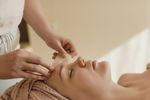During the height of the coronavirus lockdown, dermatologist Whitney Bowe, MD, author of The Beauty of Dirty Skin, had an epiphany: “I started using Peloton, but also began switching up my routine, cycling or rotating through different workouts such as pilates and yoga to optimize benefits and see changes,” she says. “I started talking about this process of cycling out different workouts and realized it was a natural response to my patients’ needs. My two worlds collided.”
Despite using exfoliants (scrubs and prescription-strength retinoids) up to twice a day, Dr. Bowe’s patients weren’t getting the results they desired.
“They were irritating their skin and not getting the benefits of powerful active ingredients,” says Dr. Bowe. “You can use a nourishing moisturizer twice a day, but when you try to push the workhorses (the acids, the retinoids) you can actually do more harm than good — including damaging the skin barrier, experiencing low-grade chronic inflammation, increasing free radical damage, accelerating the aging process and worsening hyperpigmentation. I started realizing, as we dove into patients’ actual routines, that we needed to build in recovery days to let the skin repair.”
Enter: Skin cycling. “People understood the concept of cycling for diet or exercise, so this made sense.”
RELATED: Boost Your Glow With These 8 Foods
What Is Skin Cycling?
Skin cycling is Dr. Bowe’s method of keeping over-exfoliation from damaging the skin and promoting skin recovery. (For even more details, check out the highlight reel on her Instagram account.) Though everyone is different in terms of tolerance, Dr. Bowe keeps her exfoliation to once every four days.
“I don’t skin cycle in the morning,” says Dr. Bowe. “I keep the routine predictable: cleanse, pat dry, use a vitamin C product, apply an antioxidant, moisturize and use SPF — this all protects your skin from the stressors of the day.”
The evening is when things change.
“Skin cycling is for nighttime,” she says. “I have sensitive skin, so I choose a four-day cycle. The first night or ‘exfoliation night’ of the skin cycle, I cleanse, pat dry and use an exfoliating product — I prefer a chemical exfoliant [like the Skinfix Resurface+ AHA/BHA Enzyme Exfoliating Pads] over a physical one since scrubs can cause trauma. The next step is a moisturizer. This day is all about priming your skin and fluffing away that dead surface layer of cells inhibiting your products’ ingredients from truly penetrating the skin.”
A tip from Dr. Bowe: Don’t follow an exfoliating product with a retinoid or another active-style product. The next night, use a cleanser, pat dry, apply retinol or retinoid and use moisturizer.
From there, it’s all about hydration, nourishment and re-balancing. “Avoid products with active ingredients and focus more on moisturizing with a prebiotic, squalane oil, jojoba oil, glycerin, hyaluronic, up to you,” says Dr. Bowe “Use these recovery nights to restore the skin’s barrier, pH, lipids and microbiome. When you cycle back into the actives your skin will be primed.
Sound like a lot to keep track of? Dr. Bowe recommends you get intentional and start keeping a log. She also cautions that the timing or intensity of the products in this process can change or look different for you if you’re oily or congested as opposed to dry or sensitive — for example, oilier skin types might go a bit heavier or more frequent with the exfoliation-based products, like those containing a salicylic acid.
What Are the Effects of Skin Cycling?
Though skin cycling is not in accordance with the methods on most exfoliants’ bottles, Dr. Bowe believes it’s key to accomplishing long-term skin goals.
“Patients not only tolerate active ingredients better, but also, they come back reaching skin milestones they didn’t believe possible,” says Dr. Bowe “When I introduced this concept, both those experiencing irritation and those hitting plateaus reported their skin health felt optimized and they were seeing changes.”
In a world of immediate results and aggressive exfoliation, Dr. Bowe says rest can be best. “The same thing holds true for in-office chemical peels,” says Dr. Bowe “Gentler, more superficial medical-grade peels should be used regularly for better results as opposed to harsher peels — this leads to less downtime and healthier looking skin.”
One more thing: patience is key. “Most effective skincare products take time to really deliver; immediate results may be Insta-worthy, but that’s not the key to long-term results,” says Dr. Bowe, adding: “It’s hard for people to go against what brands have been telling them, but it’s important to reconcile what the bottle or a commercial says with what’s best for your skin. We all have to slow down and think of the long-term outcome, not the superficial quick fix.”




